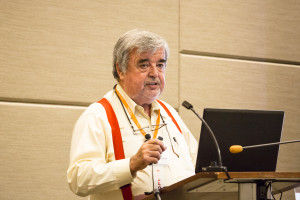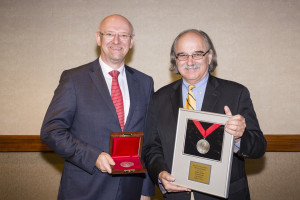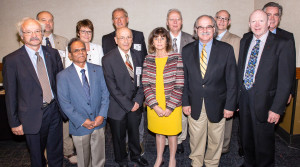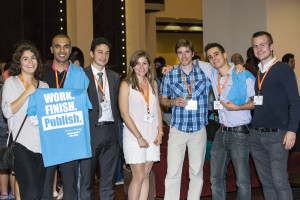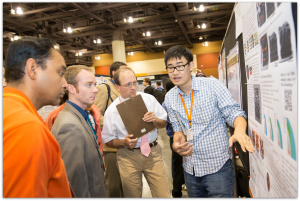 Over 2,080 people from 46 different countries attended the 228th ECS Meeting in Phoenix, Arizona, October 11-15, 2015. This was ECS’s first return visit to Phoenix since 2008. Participants could choose among 1,977 presentations.
Over 2,080 people from 46 different countries attended the 228th ECS Meeting in Phoenix, Arizona, October 11-15, 2015. This was ECS’s first return visit to Phoenix since 2008. Participants could choose among 1,977 presentations.
Check out tons of photos from the meeting on our Facebook page.
Plenary Session
ECS President Daniel Scherson opened the meeting with an update on the Society’s Free the Science initiative, a major endowment campaign allowing all ECS content to be open access—providing it at no cost to anyone—free to all authors, readers, and libraries. Attendees also got some insight into the fifth international ECS Electrochemical Energy Summit and a look at the Society’s plans for Open Access Week.
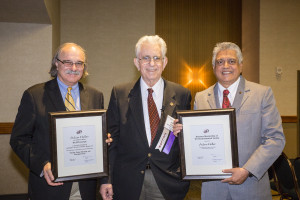
Adam Heller (center) receiving the ECS Lecture plaque from ECS President Daniel Scherson (left) and Honorary Member Plaque from ECS Vice President Krishnan Rajeshwar (right).
The ECS Lecture
“Wealth, Global Warming and Geoengineering” was the title of the ECS Lecture given by Adam Heller, Research Professor and Professor Emeritus at the University of Texas at Austin’s McKetta Department of Chemical Engineering. His talk focused on the underlying cause of the rapid rise in carbon dioxide emissions and increased energy consumption, which Heller states is due to the rise in global wealth and growth of the world’s population. Additionally, Heller stressed the need for research and development in areas of geoengineering—specifically altering the albedo to reflect more sunlight and iron fertilization of the southern oceans—in order to stop the ever-increasing effects of climate change.
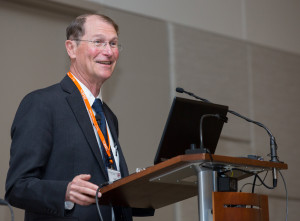
Franklin Orr, U.S. Under Secretary for Science and Energy, delivering the keynote address at the fifth international Electrochemical Energy Summit.
Electrochemical Energy Summit
The fifth international ECS Electrochemical Energy Summit (E2S) took place during the 228th ECS Meeting. The main topic was solar critical issues and renewable energy. Acknowledging population and industrial growth paired with economic and environmental issues, E2S was designed to foster an exchange between leading policy makers and energy experts about society’s needs and technological energy solutions.
Franklin Orr, U.S. Under Secretary for Science and Energy, delivered the keynote address. His talk set the tone for the summit, focusing on environmental security, the critical role of energy storage, and how we can move towards a more sustainable future.
Award Highlights
The Olin Palladium Award was presented to Digby D. Macdonald. He is the currently a Professor in Residence at the University of California, Berkeley. His work on passivity and passivity breakdown has been highly recognized among the scientific community.
The award was established in 1950 for distinguished contributions to the field of electrochemical or corrosion science. Macdonald presented his address entitled, “Some Critical Issues of the Breakdown of Passive Films.”
The Carl Wagner Memorial Award was presented to Martin Winter. He is the current Chair for Applied Materials Science for Electrochemical Energy Storage and Conversion at the Institute of Physical Chemistry at Münster University, Germany. His innovative work has focused on the research and development of new materials, components, and cell designs for batteries and supercapacitors—in particular for lithium-ion batteries—for nearly 25 years.
The award was established in 1980 to recognize a mid-career achievement and excellence in research areas of interest to the Society, and significant contributions in the teaching or guidance of students or colleagues in education, industry, or government. Winter presented his address entitled, “Anodes for Lithium Ion Batteries Revisited: From Graphite to High-Capacity Alloying- and Conversion-Type Materials and Back Again.”
ECS Chapter of Excellence Awards went to the University of Virginia and the University of Maryland.
The Outstanding Student Chapter Award went to Indiana University.
There were seven Division and Section awards:
- Battery Division Student Research Award was presented to Matteo Bianchini of the Université de Picardie Jules Verne
- Corrosion Division H.H. Uhlig Award was presented to David Shoesmith of the University of Western Ontario
- Corrosion Division Morris Cohen Graduate Student Award was presented to Eric Schindelholz of Sandia National Laboratories
- Battery Division Research Award was presented to Martin Winter of Münster University
- Europe Section Heinz Gerischer Award was presented to Adam Heller of the University of Texas at Austin
- Battery Division Technology Award was presented to Ashok Shukla of the Indian Institute of Science
- Electrodeposition Division Research Award was presented to Daniel Schwartz of the University of Washington
The ECS Certificate of Appreciation went to Paul Kohl, for his outstanding leadership during his tenure of office as President and his distinguished service that has contributed to the growth and success of the Society.
The Norman Hackerman Young Author Award for the best paper published in the Journal of The Electrochemical Society for a topic in the field of electrochemical science and technology went to Nathaniel Leonard for his paper, “Analysis of Adsorption Effects on a Metal-Nitrogen-Carbon Catalyst Using a Rotating Ring-Disk Study.”
The Bruce Deal and Andy Grove Young Author Award was presented for the best paper published in the ECS Journal of Solid State Science and Technology, for a topic in the field of solid state science and technology by young authors to Pengfei Guo, Wei Wang, and Ran Cheng for their paper, “Silicon Surface Passivation Technology for Germanium-Tin P-Channel MOSFETs: Suppression of Germanium and Tin Segregation for Mobility Enhancement.”
Krishnan Rajeshwar, ECS Senior Vice President, assisted with the introduction of the 2015 Class of Fellows. These members are being recognized for contributions to the advancement of science and technology, for leadership in electrochemical and solid state science and technology, and for active participation in the affairs of ECS.
Simon Deleonibus: Known for his achievements and breakthroughs in process modules for future miniaturization of integrated circuits, Deleonibus realized what was the world’s smallest transistor early in his career.
Raymond J. Gorte: From his esteemed research on electrodes for solid oxide fuel cells to his position as Associate Editor of the Journal of The Electrochemical Society, Gorte has made a major impact on the scientific community.
Ellen Ivers-Tiffée: With more than three decades of research in the field of functional ceramics for the energy sector, Tiffée has touched many areas of both academia and industry with her innovations in electrochemical energy storage and conversion devices.
Deborah Jones: With a dedication to innovation in fuel cell and electrolyser materials, Jones has spent the past 20 years introducing new concepts for fuel cell membrane compositions.
Robert Kostecki: Often recognized for his groundbreaking work in the field of electrochemical energy storage and conversion systems, Kostecki’s work has helped bridge the gap between fundamental science and applications of significant technological importance.
Kailash C. Mishra: While bouncing between academia and national labs, Mishra directs his research toward the development of luminescent materials.
Mogens Bjerg Mogensen: From materials science to electrochemical kinetics to reversible fuel cells to energy conversion and storage, the research conducted by Mogensen has had a great impact across the scientific community.
Emanuel Peled: Best known as the inventor and developer of the solid electrolyte interphase (SEI) model for nonaqueous alkali-metal batteries, Peled’s deep exploration of batteries throughout his career yielded him much recognition.
E. Jennings (EJ) Taylor: With 35 years of experience in industrial electrochemistry, Taylor has been focused on developing innovative electrochemical technologies at both R&D laboratories and his own company, Faraday Technology.
John A. Turner: Upon joining the National Renewable Energy Laboratory in 1979, Turner began his expansive and innovative work on photoelectrochemical water splitting from hydrogen production.
Steven Visco: As the Founder and Chief Executive Officer of PolyPlus Battery Company, Visco has been featured by TIME magazine for his innovations in battery technology.
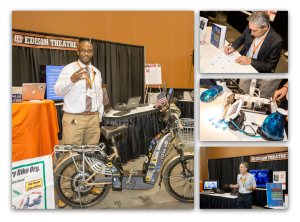 Edison Theatre
Edison Theatre
ECS’s Edison Theatre hosted a variety of live demonstrations and presentations ranging from electric transportation to hydrogen-powered cars. Telpriore Greg Tucker’s electric bike demonstration gave an insight into the future of sustainable transportation. Slobodan Petrovic showed attendees the importance of bringing solar power to remote areas of Africa through his Solar Hope presentation. Other demonstrations included the Colorado School of Mines presenting the technology behind hydrogen-powered vehicles and a Q&A session with Philippe Marcus, one of the authors of the new ECS monograph Molecular Modeling of Corrosion Processes: Scientific Development and Engineering Applications.
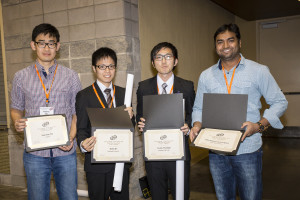
Winners of the student poster session: Xiaoxing Xia, Daiki Ito, Kenta Machida, and Subrahmanyam Goriparti.
Student Poster Contest
The student poster session awards were handed out by Daniel Scherson, ECS President; and symposium organizers Vimal Chaitanya and Kalpathy Sundaram. The winners were:
First Place Electrochemical Science and Technology: Xiaoxing Xia (Caltech)
Second Place Electrochemical Science and Technology: Subrahmanyam Goriparti (University of Genova)
First Place Solid State Science and Technology: Daiki Ito (Kogakuin University)
Second Place Solid State Science and Technology: Kenta Machida (Kogakuin University)
ECS Summer Fellowships
ECS is happy to acknowledge the Jiang Family Foundation and MTI Corporation for their generous contribution to support the Colin Garfield Fink Summer Fellowship over the course of the next 5 years.
Student Mixer
Monday night’s student mixer was a sellout, attended by over 200 students.
Student Volunteers
New to this meeting were the student volunteers who assisted meeting attendees at registration. Volunteers came from varying ECS Student Chapters to help registrants print their badges, locate technical sessions, and just chat about science.
“The student chapters and ECS meetings allow me to meet students from all different universities. These are the people I’ll be running into for the next 40 years,” says James Daubert of North Carolina State University and the Research Triangle Student Chapter. “Being here and being a volunteer allows me to network and get a look at their research.”
Exhibitors
Special thanks goes to all the meeting sponsors and exhibitors, who showcased the tools and equipment so critical to scientific research.


